|
Are volcanic glasses and tektites of the same
origin ?
Norbert Brügge, Germany
Dipl.-Geol.
mailto: [email protected]
Upload: June 2012
Update:
18.09.2020
It is urgently necessary
to brake the currently raging impact crater hysteria. With the help of meanwhile
established criteria many impact-events became postulated, mostly too quickly
and not sufficient examined. All endogenous possibilities were ignored. Still
worse, multiple is worked only with satellite pictures. Alone already the
origin of so-called tektites or impact glasses is an important discussion.
The question is, are volcanic glasses and tektites of the same origin ? Yes,
I believe it. It is a disruptive theme, that is conceded.
|
All of natural glasses found on the earth
are from amorphous structure and have a high to very high SiO2 capacity.
They are divided in four classes: Tektite, impact glasses and volcanic
glasses. However until today is not clarified, whether the practised
division of glasses is right to such classes. There is no safety, that
the locations of glass finds can be associated e.g. with impact structures,
or such are the originally location of glasses. |
|
For the existence of tektites
- emerged by an impact event - there is practically no proofs. It has
also up to now not been successful, to prove a satisfactory chemical equality
between supposed target rocks and glass locations. It is not impossible,
that most glasses found on the earth are volcanic of origin. Besides is
not finally clarified whether such "typical" criteria for an impact, like
the high temperature and high pressure minerals (e.g. Coesite, Stishovite),
shatter cone structures, planar deformations in quartz grains or breccias
(Suevite) also emerged by very high-dynamic volcanic events. Various localities,
which were classified as impact structures, would be then endogenous origin.
Striking examples for an uncertain origin are the Vredefort, Sudbury
and Popigai structures with clear igneous intrusions.
What kind of enormous dynamics by the explosion of a supervolcano is to
be expected, the idea would be, that the magma - chamber under the Yellow
Stone Park explodes again. The thrown out masses would be exposed tremendous
changes.
During an explosion of the powerful magma chamber a dynamic would emerge
presumably, which we do not know up to now. Why should a such powerful
explosion not be comparable the dynamics by an impact ?
|

Popigai structure, Siberia
|
|

Sudbury structure, Canada
|
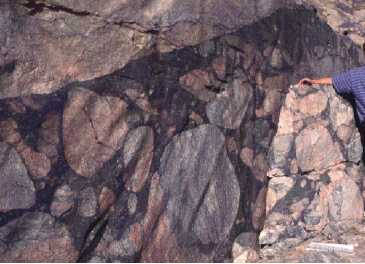
Vredefort structure, RSA
|
|
The greatest question is however:
Can document the "flying glasses" furious
volcanic outbreaks ? For that reason, if we believe to know already everything,
then we make a mistake. The known example for the unsolved origin of a
glass is the Libyan Desert Glass (LDG or LDSG). It has the highest SiO2
capacity of all natural glasses and is surely also no an impact glass.
|
Tektite and impact glasses should
be of equal origin. Tektite should be impact glasses, which are found
far from the origin location of the impact. In Europe are found the
green Moldavite. Tektite of Indochina and Australia are mostly black,
some forms are dumbbell-shaped, in part discus-shaped and flattened,
also round and spherical in many forms. Tektite have therefore often
an aerodynamic form, also a scarred surface with melted structures.
The kind of the physical characteristics the tektite resemble of the
volcanic Obsidian (the most known volcanic glass).
Tektite should differ from volcanic glasses by a higher SiO2 capacity
as well as by an extremely poor water capacity. Also so characteristic
inclusion of micro-crystals in volcanic glasses should be missing.To
improve the scarce data base of H2O content in tektites and impact
glasses, University Wien (Prof. KOEBERL) analyzed 26 tektites from
all four strewn fields and 25 impact glass samples for their H2O content.
The results show that the tektites have H2O contents ranging from
0.002 to 0.030 wt% (av. 0.014 � 0.008 wt%). Ivory Coast tektites have
the lowest H2O abundances (0.002-0.003 wt%); the Muong Nong-type indochinites
and some North American tektites having the highest contents (up to
approx. 0.03 wt%). Glasses from the Aouelloul and Zhamanshin craters
have low H2O content (0.008 to 0.063 wt%). Libyan Desert Glasses have
higher H2O content (approx. 0.11 wt%). Data confirm that all tektites
found on land have very low H2O contents (<0,03 wt% H2O), while impact
glasses have slightly higher H2O contents. Both glass types are very
dry compared to volcanic glasses. Obsidians have water content higher
as 0.20 wt%.
It becomes clear, that between all glasses in the capacity of water
no separation is to be recognized.
Are this postulated differences between impact glasses/tektites on
one hand and volcanic glasses on the other hand a so important characteristic
?
Emerged this differences by differently conditions before and during
an eruption. Sure is, that all natural glasses - also tektite and
impact glasses - can be associated with volcanic rock types. Extreme
exceptions are the LDG, the Urengoite and the Aouelloul glass with
very high or extreme high SiO2 content.
|
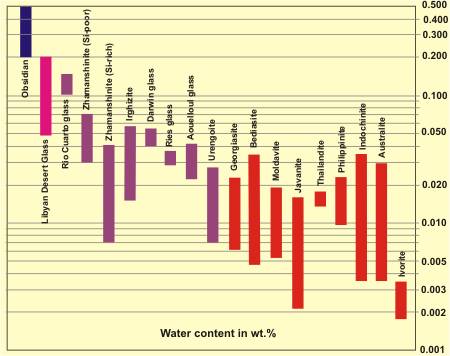
|
|
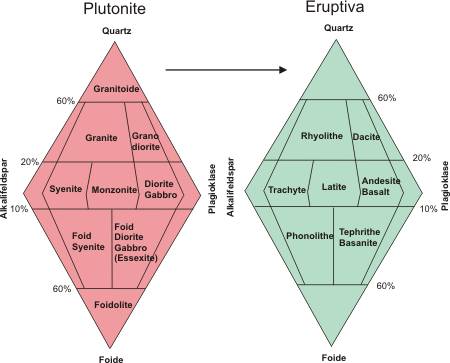
|
Short Lesson
There are two types of magmatic
(igneous) rocks
There is a wide variety of igneous rocks types but only a few basic
types of magma, because the asthenosphere and upper mantle have
a fairly uniform composition.
Plutonic rocks (intrusive) form when the magma cools slowly
beneath the surface, while eruptive volcanic rocks (extrusive)
form when magma reaches the surface and cools rapidly.
The mostly igneous rocks are composed of approximately 50 - 80 wt%
SiO2, 10 - 20 wt% Al2O3, 1 - 2 wt% MgO, 1 - 5 wt% FeO, 1 - 5 wt%
CaO, 1 - 5 wt% K2O, 1 - 2 wt% Na2O.
Igneous rocks with a capacity of < 90 wt%
of SiO2 (and that is the predominant part) can be classified in
a QAPF - diagram of the presence from light parts in the mixture
(felsic) in the rocks. This happens for plutonite and eruptiva in
separate triangles after that equal principle.
|
1. Volcanic glasses
Volcanic glass emerges from
quick cooling of gas-poor eruptiva. Volcanic glass can
refer to any of several types of vitreous igneous rocks. Most
commonly, it refers to Obsidian, a rhyolitic glass with
high silica content. Rarer are
Tachylite, a basaltic glass with relatively low silica
content.
Palagonite, a basaltic glass with relatively low silica
content.
Pele's hair, threads or fibers of volcanic glass, usually
basaltic.
Pele's tears, tear-like drops of volcanic glass, usually
basaltic.
Limu o Pele, thin sheets and flakes of brownish-green to
near-clear volcanic glass, usually basaltic.
By virtue of the quick cooling can increase no regular crystals.
The glass has with it a chaotic, amorphous structure.
The most volcanic glasses have a SiO2 capacity between 50 and
80 wt%, and are arranged in the rhyolith, trachytic, dacitic,
andesitic and basaltic families of eruptive rocks.
Volcanic glasses can contain inclusions of radial increased structures,
so-called spherolithes. These minerals, mostly feldspars or Cristobalit
(a high temperature modification of quartz) increased spherical
at a kernel in the surrounding melt, until stopped this process
the cooling. |

|
2. Tektite glasses
are similar in chemistry to terrestrial
volcanic glass.
From the geochemical point of view the chemical analysis characterizes
at all the tektite glasses as rhyolitic or dacitic (as
well as the Obsidian). The melt is oversaturated in SiO2 and
molecular Al2O3 and their concentration is but clearly greater
than the sum of Na2O + K2O + CaO in comparison to the Obsidian.
The tektite glasses are peraluminous.
Also by the alkali-lime index (Na2O + K2O) and CaO in terms
of SiO2 the tektite glasses are determined characterized by
a rhyolitic composition.
Glasses were formed from a rhyolitic or dacitic volcanic melt.
They are characterized as high polymerized network glasses in
with respect to their glass structure by the chemical composition,
(especially by the SiO2-content), as high polymerized network
glasses. |
|

|

|
|
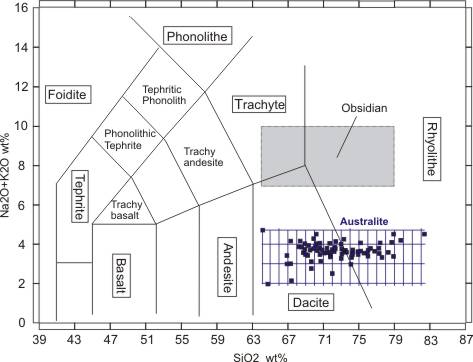
|

|
3. "Impact glasses"
Glasses - as the
result of an impact classified - have an extensive spectrum
of their composition. Accordingly the silica/alkaline index
are some glasses nearby the Obsidian or the Tektites. Most
glasses can be associated however with volcanic lava or other
fluid melts ("Impactite" melt glass).
|
|
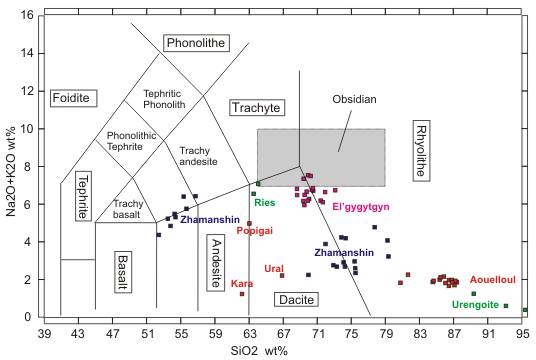
|
Between Obsidian - the most
frequent volcanic glass - and the tektites as well as impact
glasses gives however a striking difference of chemistry.
The part of Na2O+K2O is at the volcanic Obsidian approximately
doubly so much as at tektitic glasses. That means, that the
Obsidian is emerged by rhyolitic-trachytic eruptions, and
the tektites (incl. Moldavite) is emerged by rhyolitic-dacitic
eruptions. It is not a feature to separate both.
Also is interesting, that the glasses of the El'gygytgyn -
classified as impact glasses - have a clear affinity to the
Obsidian.
With a great amount of chemical analyses of different glaziers
(incl. mikrotektites) the thesis of the volcanic origin of
all glasses can be proven (at least of the tektite). The here
presented analyses are freely accessible in the internet. |
|
1. Volcanic glass
|
|
Hawaii Glass (Hawaii) |
Eruptiva type: Basaltic
|
Age: Recently |
|
|
|
Oxide (wt%)
|
Hawaii glass |
|
SiO2
|
51.80 |
|
Al2O3
|
10.20 |
|
TiO2
|
2.70 |
|
FeO
|
12.0 |
|
MgO
|
8.00 |
|
CaO
|
8.60 |
|
Na2O
|
1.60 |
|
K2O
|
0.40
|
|

Volcanic "Pele's tears"
|
|

Limu o Pele
|
|
Chimgau
"Tektite" (Germany) |
Type: Eruptiva
|
Age: Pleistocene
? |
|
The so-called tektites
of the Chiemgau strewn-field are the latest testimonies
of a long-living vulcanism, of which numerous structures
have been preserved in the southern German region. These
include also the Nördlinger Ries and the Steinheimer Becken
insistent classified as "impact" craters. |
|


Out of focus, because the use
was not approved by the authors
|
|
Atacama
"Tektite" (Chile) |
Eruptiva type:
|
Age:
|
|
In 2014, a new strewn field
of splash forms with clearly volcanic origin was found
in the Atacama desert. |
|

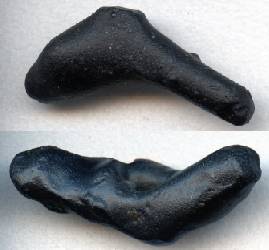
|
|
Irghizite
(Zhamanshin Crater, Kasakhstan) |
Eruptiva type:
Dacitic-rhyolitic
+ Basaltic-andesitic
|
Age: 0.9 - 1.1
Ma (Pleistocene) |
|
The Zhamanshin structure
is a circle depression ~6 km in diameter. The rim is formed
of brecciated rocks. The structure include larger irregularly-shaped
fragments and blocks of glassy melt (Zhamanshinite),
and three types of splash-form glasses (Irghizite).
These glassy objects typically are up to 30 mm large and
are shaped as teardrops, irregularly bent and curved glass
rods and fibers. They can be subdivided into acidic types
(typically 69�76 wt.% SiO2) and basic types (typically
53�56 wt.% SiO2). That mean, Irgizhite are of dacitic-rhyolitic
and basaltic-andesitic origin. The Irghizite
glass include bubbles and grains of lechatelierite in
some places. The water content of these glasses is with
maximum 0.059 wt% atypically for an impactite glass. A
volcanic origin of these glasses is much more probable.
The Zhamanshin crater would be an endogenous structure
with two (?) different eruptions. The related glassy melt
bodies (Zhamanshinite) are of the same different origin
as the Irghizite. |
|
Oxide (wt%)
|
Irghizite
|
|
Bouska et al. (1981)
|
Jonasova et al. (2016)
|
|
acidic type
|
acidic type |
basic type |
|
range (31)
|
average
|
range (19)
|
average |
range (5)
|
average |
|
SiO2
|
70.00 |
79.44 |
74.12 |
68.04 |
75.41 |
72.95 |
53.48 |
55.68 |
54.27 |
|
Al2O3
|
9.45 |
13.60 |
10.19 |
8.49 |
11.50 |
9.73 |
19.93 |
20.62 |
20.20 |
|
TiO2
|
0.69 |
0.99 |
0.82 |
0.71 |
0.83 |
0.76 |
0.81 |
0.87 |
0.83 |
|
FeO
|
4.24 |
6.81 |
5.58 |
5.50 |
9.21 |
6.49 |
8.19 |
8.67 |
8.42 |
|
MgO
|
2.16 |
3.76 |
2.82 |
2.43 |
4.92 |
3.18 |
2.48 |
2.92 |
2.73 |
|
CaO
|
1.75 |
2.85 |
2.48 |
2.20 |
3.93 |
2.66 |
6.20 |
8.35 |
7.59 |
|
Na2O
|
0.85 |
1.22 |
1.09 |
0.56 |
1.09 |
0.97 |
4.01 |
4.31 |
4.17 |
|
K2O
|
1.58 |
2.14 |
1.96 |
1.65 |
2.04 |
1.94 |
1.25 |
1.44 |
1.33 |
|

|
|


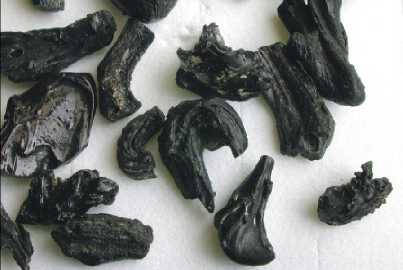
|
|
|
|
Mimbral Glass
(Mexico) |
Eruptiva type: Andesitic
+ Trachybasaltic
|
Age: ~65 Ma |
|

Glass from the Middle
American volcanism
|

Source: Bell & Sharpton
(1996)
|
|
Beloc
Glass (Haiti)
|
Eruptiva
type: Andesitic-dacitic
|
Age: ~65 Ma |
|
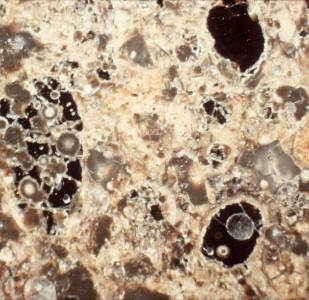
Glass from the Middle
American volcanism
|

Source: Izett et
al.(1990) & Stueben et al.(2002)
|
|
Obsidian (world
wide) |
Eruptiva type:
Rhyolitic-trachytic |
Age: ? |
The
Obsidian is the classic worldwide occurring volcanic glass.
Obsidian is a type of naturally-occurring glass formed
as an extrusive igneous rock. It is produced when felsic
lava erupted from a volcano cools rapidly through the
glass transition temperature and freezes without sufficient
time for crystal growth. Obsidian is commonly found within
the margins of rhyolitic lava flows known as obsidian
flows, where cooling of the lava is rapid.
Obsidian is mineral-like, but not a true mineral because
it is not crystalline. It is sometimes classified as a
mineraloid. While a rock like basalt is dark because of
ferromagnesian enrichment, obsidian consists mainly of
SiO2 (silicon dioxide), usually 70% or more. The most
Obsidians are arranged in the trachytic and rhyolith families
of eruptive rocks. Rhyolithe are the volcanic equivalents
of the granites. Because obsidian is metastable at the
earth's surface (over time the glass becomes fine-grained
mineral crystals), no obsidian has been found that is
older than Cretaceous age. Obsidian has a chaotic, amorphous
structure. However can be embedded single crystals in
more or less great quantities in the glassy mass. Obsidian
glasses can contain inclusions of radial increased structures,
so-called spherolithes. These minerals, mostly feldspars
or Cristobalit (a high temperature modification of quartz)
increased spherical at a kernel in the surrounding melt,
until stopped this process the cooling. The breakdown
of obsidian is accelerated by the presence of water. Obsidian
contain approx. 0.2 -0.5 wt% water.
While pure obsidian is usually dark in appearance, the
colour varies depending on the presence of impurities.
Iron and magnesium typically give the obsidian a dark
green to brown to black colour. A very few samples are
nearly clear. In some stones, the inclusion of small,
white, radially clustered crystals of cristobalite in
the black glass produce a blotchy or snowflake pattern
(snowflake obsidian). It may contain patterns of gas bubbles
remaining from the lava flow, aligned along layers created
as the molten rock was flowing before being cooled. These
bubbles can produce interesting effects such as a golden
(sheen obsidian) or rainbow sheen (rainbow obsidian).
Obsidian can be found in many locations around the world
which have experienced rhyolitic eruptions. Obsidian can
be found in North America, Mexico, Peru, Iran, Armenia,
Turkiye, Italy, Greece and Scotland.
The colours in obsidian result from the oxidation state
of the chemical elements within the tiny minerals that
are finely dispersed in the glass. Black colour results
chiefly from magnetite, Fe304. If the obsidian is highly
oxidized, then the glass may contain hematite, which provides
a reddish hue. Variations in the oxidation state of the
iron (Fe) varieties imparts a slight greenish hue. Some
obsidian is banded, a consequence of oxidation on a flow
surface being folded into the lava as it continues to
move.
|
|
Oxide (wt%)
|
Shahryri (Iran)
|
Lipari Islands
(Italia)
|
Yellowstone
(USA)
|
New Mexico (USA)
|
|
Nadooshan et
al., 2007 |
Hunt et al.,
1998 |
Hatch et al.,
1972 |
Hölzle-Y., 1992 |
Rose et al. |
|
range (12) |
average |
range (45) |
average |
average (?) |
average (?) |
average (?) |
|
SiO2
|
62.75 |
79.29 |
70.90 |
73.59 |
75.61 |
74.26 |
76.78 |
75.00 |
76.40 |
|
Al2O3
|
8.76 |
12.02 |
10.73 |
12.76 |
13.67 |
13.16 |
12.09 |
12.50 |
12.70 |
|
TiO2
|
0.09 |
0.12 |
0.11 |
0.03 |
0.14 |
0.08 |
0.08 |
0.11 |
0.10 |
|
FeO
|
0.66 |
1.35 |
0.96 |
1.27 |
1.67 |
1.50 |
2.61 |
1.00 |
0.58 |
|
MgO
|
0.02 |
0.23 |
0.07 |
0.02 |
0.07 |
0.04 |
0.10 |
0.03 |
0.40 |
|
CaO
|
? |
? |
? |
0.66 |
0.80 |
0.74 |
0.57 |
0.60 |
0.30 |
|
Na2O
|
3.58 |
4.10 |
3.80 |
2.44 |
4.27 |
3.84 |
3.79 |
2.90 |
4.10 |
|
K2O
|
3.48 |
4.15 |
4.00 |
5.00 |
5.33 |
5.13 |
4.93 |
5.10 |
4.57 |
|
|
|
Oxide (wt%)
|
Anatolia (Turkiye)
|
|
Bingöl |
Nenezidag |
Erzincan |
Sakaeli-Orta |
Acigöl
(E) |
Acigöl (W) |
Göllüdag (E) |
Göllüdag (W) |
|
ave. (16) |
ave. (15) |
ave. (3) |
ave. (6) |
ave. (15) |
ave. (6) |
ave. (11) |
ave. (11) |
ave. (15) |
ave. (7) |
ave. (8) |
ave. (6) |
|
SiO2
|
74.70 |
70.90 |
73.60 |
72.80 |
75.70 |
74.20 |
74.90 |
76.10 |
75.80 |
75.50 |
76.30 |
75.30 |
|
Al2O3
|
11.60 |
15.70 |
14.50 |
14.90 |
14.10 |
14.70 |
14.10 |
13.80 |
13.40 |
13.30 |
13.00 |
13.70 |
|
TiO2
|
0.16 |
0.16 |
0.13 |
0.08 |
0.14 |
0.08 |
0.06 |
0.03 |
0.05 |
0.05 |
0.06 |
0.11 |
|
FeO
|
2.94 |
1.34 |
0.90 |
1.75 |
0.75 |
1.03 |
0.82 |
0.67 |
0.63 |
0.67 |
0.65 |
1.02 |
|
MgO
|
0.08 |
0.18 |
0.16 |
0.08 |
0.10 |
0.12 |
0.07 |
0.03 |
0.40 |
0.47 |
0.06 |
0.10 |
|
CaO
|
0.52 |
0.96 |
1.18 |
0.97 |
0.87 |
0.96 |
0.81 |
0.55 |
0.67 |
0.64 |
0.70 |
0.88 |
|
Na2O
|
5.80 |
5.14 |
4.84 |
4.36 |
3.57 |
4.63 |
4.46 |
4.45 |
4.57 |
4.94 |
4.52 |
4.27 |
|
K2O
|
4.06 |
4.93 |
4.40 |
4.32 |
4.75 |
4.34 |
4.45 |
4.27 |
4.58 |
4.63 |
4.56 |
4.14 |
|
|
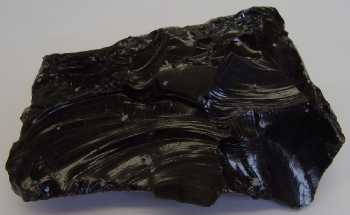
|
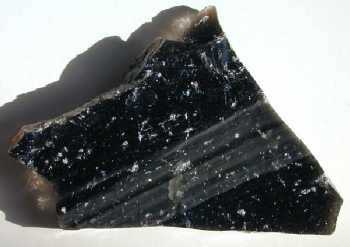
|
|
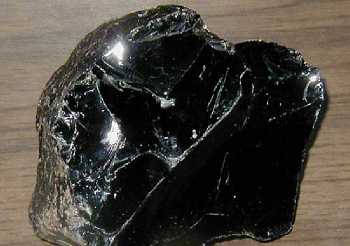
|
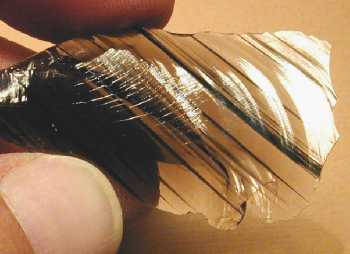
Dark bands in
the brownish matrix
|
|
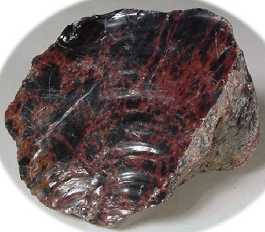
|

|
|

|

|
|
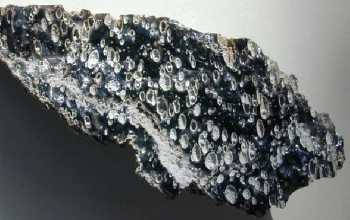
|

|
|
Apache
Tears (Arizona, USA) |
Eruptiva
type: Rhyolitic ? |
Age:
? |
|
Apache Tears
is Obsidian |
|
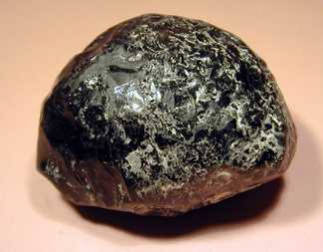
|

|
|
Colombianite
(Colombia, Peru) |
Eruptiva
type: Rhyolitic ? |
Age:
15 Ma ? (Miocene) |
|
The Columbianite
are unusual glasses. They become mainly
found in the region of the Orinoco river,
Colombia. The glasses were counted up to
now among the tektite, because the structure
at the surface is similar to tektites. The
chemical composition however clearly should
correspond the Obsidians. |
|

|

|
|
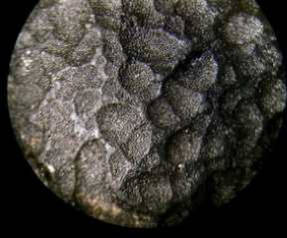

|
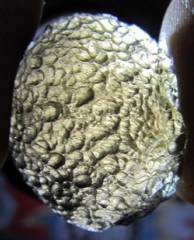
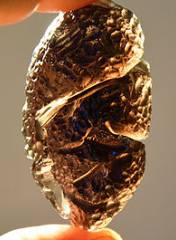
|
|
Darwin
Glass (Tasmania, Mt. Darwin) |
Eruptiva
type: Rhyolitic |
Age:
? |
|
The Darwin
Glass is found nearby the Mt. Darwin volcanic
crater in Tasmania. Chemical analyses
suggest the presence of 2 groups of glasses.
The ranges in major element composition
in group 1 are: SiO2 (80.62 - 93.9%),
Al2O3 (3.14 - 10.6%), TiO2 (0.2 - 0.76%),
FeO (0.8 - 4.23%), MgO (0.25- 2.31%) and
K2O (0.7 - 2.7%). CaO and Na2O are almost
completely absent in all analyses. Group
1 glass is predominantly light to dark
green, white or sometimes black. The second
population has a lower average abundance
of SiO2 (81.16%). The average MgO (2.2%)
and FeO (3.8%) content in this group is
significantly higher than in group 1 glasses
and Al2O3 is also slightly enriched. Group
2 glass is predominantly black to dark
green and rarely light green in colour.
The compositions of the Darwin glasses
is similar to the Urengoites and
Aouelloul glass. They are volcanic
glasses. |
|


|
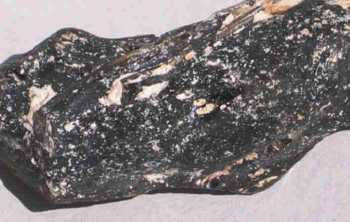

|
|
Libyan
Desert Glass (Egypt) |
Type:
Volcanic
(Unique
opaline glass)
|
Age:
28 -29 Ma (Oligocene) |
The
Libyan Desert Glass is classified still
always as tektite or impact glass. That
is nonsense. The LDG can be arranged in
no known class up to now. No natural glass
has a SiO2 content with more than 95 wt%.
It is an low-water opaline glass of the hyalite group and is unique
on the world up to now.
See my report here
|
|
Oxide (wt%)
|
Gucsik at al., 2004
|
Giuli et al., 2003
|
Guzzafame et al., 2009
|
|
bright variety
|
dark variety
|
bright
|
bright
|
dark streak
|
yellow
|
green
|
|
range (8)
|
average
|
range (6)
|
average
|
single
|
single
|
single
|
single
|
single
|
single
|
|
SiO2
|
96.40
|
98.10
|
97.20
|
92.80
|
97.80
|
95.97
|
98.44
|
98.27
|
95.85
|
97.19
|
96.71
|
92.52
|
|
Al2O3
|
0.49
|
1.70
|
1.12
|
0.07
|
2.39
|
1.30
|
0.55
|
1.30
|
1.48
|
0.86
|
1.19
|
1.88
|
|
TiO2
|
0.06
|
0.38
|
0.21
|
0.15
|
0.85
|
0.36
|
0.08
|
0.17
|
0.18
|
0.07
|
0.20
|
0.81
|
|
MnO
|
0.08
|
0.44
|
0.24
|
0.09
|
0.92
|
0.31
|
0.01
|
0.01
|
0.02
|
-
|
-
|
0.03
|
|
FeO
|
0.04
|
0.55
|
0.22
|
0.09
|
1.06
|
0.36
|
0.09
|
0.12
|
0.98
|
0.06
|
0.14
|
2.09
|
|
MgO
|
0.09
|
0.51
|
0.32
|
0.03
|
0.58
|
0.32
|
0.01
|
0.01
|
1.38
|
0.08
|
0.11
|
0.13
|
|
CaO
|
0.04
|
0.18
|
0.13
|
0.09
|
1.88
|
0.47
|
0.01
|
0.01
|
0.08
|
0.08
|
0.06
|
0.85
|
|
Na2O
|
0.04
|
0.43
|
0.22
|
0.03
|
0.40
|
0.21
|
0.01
|
0.03
|
0.02
|
0.85
|
0.99
|
0.53
|
|
K2O
|
0.05
|
0.26
|
0.12
|
0.14
|
0.38
|
0.24
|
0.01
|
0.01
|
0.01
|
0.27
|
0.15
|
0.25
|
|
|

|

|
|
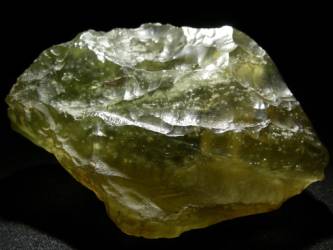
|
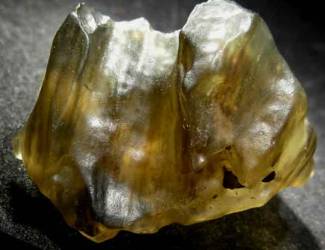
|
|

|

|
|
2. Tektite & Microtektite
|
|

|
Tektites are a group of natural
glasses occurring in at least
four different strewn fields on
earth. The largest strewn field
includes Australia, Philippines,
Indonesia, Vietnam, Thailand,
Cambodia, Laos, Tibet and the
southern China. Tektites are generally
small, brownish to black, partly
transparent, spherically symmetric,
and sometimes aerodynamically
ablated. Strewn fields are geographically
restricted areas on earth where
tektites are found, usually in
association with microtektites.

|
Mikrotectites belonging
to the Australasian, Ivory Coast,
and North American tektite strewn
fields have been found in marine
sediments adjacent to the respective
tektite strewn fields.
Australasian microtektites habe
been recovered from approx. 50
cores taken in the Indian Ocean,
western equatorial Pacific Ocean,
and Philippine, Sulu, Celebes,
and South China Seas. The Australasian
microtektites are Middle Pleistocene
in age.
North American microtektites have
been found in Upper Eocene marine
sediments on Barbados and in cores
recovered from the Gulf of Mexico,
Caribbean Sea, and north-western
Atlantic Ocean (continental slope
off New Jersey). The layers from
Barbados indicates an age of ~35
Ma. The major oxide composition
and age of the North American
microtektites (and tektite fragments)
suggest that they too belong to
the North American tektite strewn
field.
The Ivory Coast microtektites
have been found in 11 cores in
the eastern equatorial Atlantic
Ocean. The layers is also Middle
Pleistocene in age (~1.1 Ma).
They have a restricted range in
major element composition compared
with the Australasian and North
American microtektites.
|
|
Moldavite
(Europe)
|
Eruptiva
type: Rhyolitic
|
Age: 14.4 - 15.1 Ma (Miocene)
|
|
The Moldavite are rhyolitic
glasses. Their affinity to the
supposed German impact structures
-- the Nördlinger Ries or the
Steinheim basin -- is arbitrary.
In the Bohemia and Moravia regions
exist numerous Miocene volcanic
structures, which come in consideration
as source.
|
|
Oxide (wt%)
|
Bouska et al. (1973) etc. |
Bouska et al. (1973) etc. |
Bouska et al. (1995) |
Koeberl et al. (1988) |
|
Moravia |
Bohemia |
Cheb |
Austria |
|
range (21) |
average |
range (61) |
average |
range (4) |
average |
range (7) |
average |
|
SiO2
|
74.90 |
81.40 |
78.15 |
75.50 |
85.10 |
80.30 |
78.46 |
79.89 |
78.97 |
78.10 |
85.10 |
79.73 |
|
Al2O3
|
9.44 |
13.80 |
11.62 |
7.32 |
11.40 |
9.36 |
8.38 |
10.13 |
9.17 |
8.10 |
10.60 |
9.81 |
|
TiO2
|
0.31 |
1.40 |
0.85 |
0.24 |
0.74 |
0.49 |
0.28 |
0.40 |
0.33 |
0.24 |
0.35 |
0.30 |
|
FeO
|
1.72 |
3.50 |
2.61 |
1.08 |
2.93 |
2.00 |
1.34 |
1.86 |
1.54 |
1.02 |
1.78 |
1.54 |
|
MgO
|
1.13 |
2.06 |
2.00 |
1.34 |
2.74 |
2.04 |
1.86 |
2.75 |
2.34 |
1.10 |
2.03 |
1.72 |
|
CaO
|
0.95 |
3.17 |
2.06 |
1.21 |
3.96 |
2.58 |
2.35 |
4.56 |
3.60 |
1.46 |
3.30 |
2.41 |
|
Na2O
|
0.40 |
1.08 |
0.74 |
0.20 |
0.89 |
0.54 |
0.31 |
0.59 |
0.41 |
0.19 |
0.49 |
0.39 |
|
K2O
|
2.83 |
3.81 |
3.32 |
2.23 |
3.81 |
3.02 |
2.61 |
3.85 |
3.24 |
2.62 |
3.90 |
3.49 |
|
|
Oxide (wt%)
|
Lange (1995)
|
|
Southern Bohemia
|
Radomilice
|
Western Moravia
|
Lusatian area
|
|
range (43)
|
average
|
range (3)
|
average
|
range (46)
|
average
|
range (15)
|
average
|
|
SiO2
|
71.90
|
81.00
|
78.60
|
80.00
|
84.70
|
82.60
|
74.91
|
83.10
|
79.28
|
77.2
|
84.10
|
79.30
|
|
Al2O3
|
8.96
|
12.70
|
10.10
|
7.27
|
9.36
|
8.22
|
9.27
|
13.18
|
11.01
|
8.94
|
11.80
|
10.50
|
|
TiO2
|
0.23
|
0.50
|
0.31
|
0.24
|
0.29
|
0.26
|
0.30
|
0.72
|
0.42
|
0.26
|
0.42
|
0.34
|
|
FeO
|
1.28
|
2.86
|
1.62
|
1.00
|
1.41
|
1.18
|
1.40
|
3.50
|
2.26
|
1.32
|
2.51
|
1.84
|
|
MgO
|
1.52
|
3.73
|
2.33
|
1.60
|
2.26
|
1.91
|
0.88
|
2.11
|
1.39
|
1.06
|
2.73
|
1.75
|
|
CaO
|
2.05
|
4.48
|
2.98
|
1.80
|
2.82
|
2.29
|
0.61
|
3.11
|
1.64
|
0.93
|
3.85
|
2.00
|
|
Na2O
|
0.25
|
0.60
|
0.42
|
0.19
|
0.32
|
0.24
|
0.27
|
1.08
|
0.57
|
0.28
|
0.70
|
0.47
|
|
K2O
|
2.88
|
3.77
|
3.40
|
2.20
|
2.97
|
2.53
|
2.60
|
3.81
|
3.38
|
3.06
|
3.75
|
3.46
|
|
|



|
|

|

|
|

|

|
|
Indochinite
(Indochina)
|
Eruptiva
type: Rhyolitic
|
Age: 0.7 - 0.8 Ma
(Pleistocene)
|
Indochinite are Fe-rich
rhyolitic glasses.
They are found far spreads
in a region, in which
since long time of the
earth history volcanic
activities intense presumably
already ruled. The large
strewn field includes
Philippines, Indonesia,
Vietnam, Thailand, Cambodia,
Laos, Tibet and the southern
China. Probable have thrown
powerful volcanic explosions
the glassy masses until
on the Australian craton
(Australite).
Within one strewn field,
we can distinguish between
splash-form tektites (normal
tektites) and so called
Muong Nong tektites, which
differ from normal tektites
in respect to a higher
volatile content and greater
inhomogeneity, besides
being of generally larger
size.
|
|
Oxide wt%)
|
Son & Koeberl
(2004)
|
Chapman & Scheiber
(1969)
|
Koeberl (1992)
|
Barnes & Pitakpaivan
|
Lee et al.
|
|
Philippines (splash-type)
|
Vietnam (MN-type)
|
Philippinite
|
MN-typ
|
splash-typ
|
Phang Daeng
(Thailand)
|
East Asia
|
|
range (6)
|
average
|
range (11)
|
average
|
range (12)
|
average
|
average (19)
|
average (?)
|
range (5)
|
average
|
average (30)
|
|
SiO2
|
71.63
|
73.21
|
72.62
|
74.92
|
78.14
|
77.05
|
67.20
|
74.90
|
70.62
|
78.93
|
72.70
|
72.44
|
80.40
|
75.42
|
74.36
|
|
Al2O3
|
11.69
|
12.04
|
11.87
|
10.07
|
12.20
|
11.08
|
8.90
|
17.70
|
13.20
|
10.18
|
13.37
|
9.50
|
13.34
|
11.72
|
11.13
|
|
TiO2
|
0.67
|
0.74
|
0.71
|
0.65
|
0.77
|
0.71
|
0.50
|
1.00
|
0.76
|
0.63
|
0.78
|
0.62
|
0.76
|
0.70
|
0.78
|
|
FeO
|
3.89
|
4.30
|
4.16
|
3.67
|
4.21
|
3.88
|
3.87
|
5.87
|
4.80
|
3.74
|
4.58
|
3.00
|
4.29
|
3.72
|
4.99
|
|
MgO
|
2.08
|
2.14
|
2.13
|
1.52
|
1.77
|
1.79
|
1.87
|
3.15
|
2.44
|
1.43
|
2.14
|
1.30
|
2.00
|
1.76
|
2.59
|
|
CaO
|
3.68
|
3.81
|
3.77
|
1.18
|
1.39
|
1.27
|
1.37
|
9.77
|
4.08
|
1.21
|
1.98
|
1.10
|
2.24
|
1.85
|
2.14
|
|
Na2O
|
1.09
|
1.22
|
1.66
|
1.04
|
1.20
|
1.09
|
0.91
|
1.50
|
1.19
|
0.92
|
1.05
|
1.20
|
1.62
|
1.48
|
1.43
|
|
K2O
|
2.32
|
2.44
|
2.39
|
2.35
|
2.53
|
2.46
|
1.77
|
2.81
|
2.34
|
2.42
|
2.62
|
2.20
|
2.48
|
2.35
|
2.39
|
|
|
|
Oxide wt%)
|
Lee et al. (2003)
|
|
Wenchang
(China)
|
Penglei
(China)
|
Khon Kaen
(Thailand)
|
Bao Loc
(Vietnam)
|
Maoming
(China)
|
Rizal
(Philippines)
|
|
range (5)
|
average
|
range (5)
|
average
|
range (5)
|
average
|
range (5)
|
average
|
range (5)
|
average
|
range (5)
|
average
|
|
SiO2
|
72.12
|
72.69
|
72.49
|
71.84
|
74.49
|
73.06
|
72.18
|
74.07
|
73.25
|
72.26
|
73.61
|
72.93
|
77.26
|
80.61
|
78.53
|
75.10
|
76.95
|
75.87
|
|
Al2O3
|
12.88
|
14.32
|
13.73
|
12.47
|
14.61
|
13.54
|
13.19
|
14.47
|
13.75
|
12.35
|
12.81
|
12.61
|
5.15
|
8.46
|
7.06
|
5.35
|
6.99
|
6.07
|
|
TiO2
|
0.73
|
0.79
|
0.75
|
0.71
|
0.82
|
0.77
|
0.70
|
0.78
|
0.74
|
0.82
|
0.84
|
0.83
|
0.72
|
0.84
|
0.78
|
0.78
|
0.89
|
0.82
|
|
FeO
|
5.05
|
5.34
|
5.16
|
4.29
|
4.72
|
4.55
|
4.99
|
5.34
|
5.15
|
4.43
|
4.56
|
4.52
|
4.70
|
5.52
|
5.11
|
5.30
|
5.63
|
5.45
|
|
MgO
|
3.15
|
3.65
|
3.38
|
1.47
|
1.82
|
1.70
|
2.57
|
2.80
|
2.69
|
2.57
|
2.71
|
2.62
|
2.10
|
2.64
|
2.31
|
2.71
|
2.92
|
2.87
|
|
CaO
|
1.01
|
1.12
|
1.10
|
1.85
|
2.08
|
1.97
|
0.34
|
0.45
|
0.43
|
1.59
|
2.11
|
1.76
|
2.61
|
3.29
|
3.01
|
3.58
|
5.04
|
4.58
|
|
Na2O
|
1.33
|
1.45
|
1.40
|
1.40
|
1.63
|
1.53
|
1.33
|
1.48
|
1.40
|
1.24
|
1.35
|
1.32
|
1.18
|
1.43
|
1.30
|
1.57
|
1.76
|
1.62
|
|
K2O
|
2.14
|
2.34
|
2.30
|
2.53
|
2.65
|
2.61
|
1.98
|
2.26
|
2.15
|
2.38
|
2.53
|
2.45
|
2.12
|
2.38
|
2.27
|
2.44
|
2.68
|
2.54
|
|
| |
|
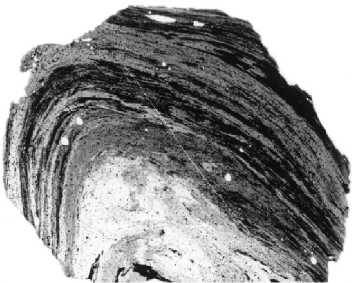
Section through an
Indochinite
|

Thin slice
|
|

|

Vietnam
|
|

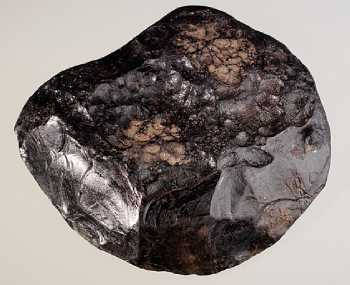

Thailand
|
|

China
|

Philippines
|
|



China
China
China
|
|
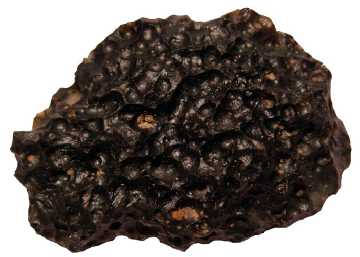
Philippines
|

Philippines
|
|
Tibetanite
(Tibet)
|
Eruptiva
type: Rhyolitic
|
Age:
0.7 - 0.8 Ma
(Pleistocene)
|
|
The specimens
from Tibet resembled
typical Indochinites
in superficial
appearance and
colour. The
results of chemical
analysis were
essentially
identical to
Indochinites.
By the K/Ar
dating found
to be 0.76 Ma.
also consistent
with the Australasian
strewn field.

|
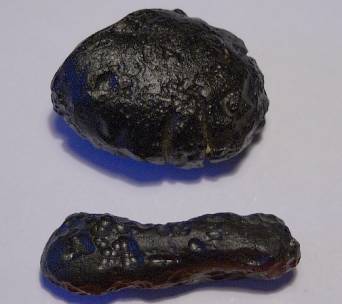
|
|
Australite
(Australia)
|
Eruptiva
type: Rhyolitic
|
Age:
0.7 - 0.8 Ma
(Pleistocene)
|
|
The Australite
like the Indochinite
are Fe- rich
rhyolitic
glasses. Both
types belong
to the strewn-field
"Australasian".
|
|
Oxide
(wt%)
|
Australites
(Mason,
1979)
|
Australites
(Taylor
& Sachs,
1964)
|
Australasian
tektites
(Chapman
& Scheiber,
1969)
|
Australasian
MN-type
(Glass
& Koeberl,
1989)
|
|
range
(60)
|
average
|
range
(15)
|
average
|
range
(51)
|
average
|
range
(8)
|
average
|
average
(?)
|
|
SiO2
|
67.30
|
78.90
|
73.06
|
69.67
|
77.39
|
73.53
|
64.76
|
82.40
|
73.58
|
67.40
|
73.15
|
70.28
|
72.50
|
|
Al2O3
|
9.50
|
15.90
|
12.23
|
9.84
|
13.96
|
11.90
|
8.20
|
17.70
|
12.95
|
10.90
|
12.90
|
11.90
|
12.94
|
|
TiO2
|
0.59
|
0.85
|
0.68
|
0.60
|
0.90
|
0.75
|
0.43
|
1.00
|
0.72
|
0.64
|
0.76
|
0.70
|
0.76
|
|
FeO
|
3.55
|
6.10
|
4.14
|
3.84
|
5.48
|
4.66
|
3.09
|
8.63
|
5.86
|
5.65
|
7.82
|
6.74
|
4.76
|
|
MgO
|
1.31
|
3.53
|
2.04
|
1.60
|
2.89
|
2.24
|
1.13
|
7.95
|
4.54
|
3.48
|
6.38
|
4.93
|
2.08
|
|
CaO
|
1.57
|
5.93
|
3.38
|
2.39
|
4.77
|
3.58
|
0.73
|
9.77
|
5.25
|
2.10
|
3.47
|
2.78
|
2.49
|
|
Na2O
|
0.91
|
1.74
|
1.27
|
1.05
|
1.50
|
1.28
|
0.62
|
1.70
|
1.16
|
0.62
|
1.22
|
0.92
|
1.42
|
|
K2O
|
2.08
|
2.78
|
2.20
|
2.07
|
2.57
|
2.32
|
1.34
|
2.81
|
2.08
|
1.44
|
2.23
|
1.84
|
2.64
|
|
|
|
|
Oxide
(wt%)
|
Australites
(Chapman
&
Scheiber,
1969)
|
Australites
(Taylor
&Sachs,
1964)
|
Australasian
Microtektites
(Glass
et
al.,
2003)
|
|
range
(11)
|
average
|
range
(23)
|
average
|
range
(32)
|
average
|
range
(30)
|
average
|
range
(7)
|
average
|
|
SiO2
|
66.90
|
79.70
|
71.13
|
66.90
|
79.70
|
73.30
|
69.60
|
78.70
|
74.15
|
60.48
|
78.05
|
69.60
|
66.69
|
72.01
|
69.35
|
|
Al2O3
|
9.30
|
16.10
|
13.72
|
9.90
|
16.10
|
13.00
|
9.35
|
14.00
|
11.68
|
10.25
|
21.46
|
14.90
|
12.48
|
14.94
|
13.54
|
|
TiO2
|
0.49
|
0.93
|
0.79
|
0.48
|
0.93
|
0.70
|
0.55
|
0.90
|
0.72
|
0.64
|
1.18
|
0.82
|
0.69
|
0.81
|
0.75
|
|
FeO
|
3.57
|
5.43
|
4.78
|
3.57
|
6.06
|
4.82
|
3.83
|
5.38
|
4.60
|
2.90
|
6.32
|
5.08
|
5.11
|
6.77
|
5.96
|
|
MgO
|
1.31
|
2.60
|
2.21
|
1.31
|
4.28
|
2.80
|
1.49
|
2.49
|
1.99
|
1.67
|
5.07
|
3.23
|
2.90
|
4.17
|
3.41
|
|
CaO
|
1.83
|
5.48
|
3.45
|
1.72
|
5.62
|
3.67
|
2.13
|
5.09
|
3.61
|
1.63
|
6.56
|
3.52
|
2.37
|
4.30
|
3.06
|
|
Na2O
|
1.00
|
1.56
|
1.24
|
1.00
|
1.58
|
1.29
|
1.05
|
1.52
|
1.28
|
0.28
|
1.70
|
0.92
|
0.98
|
1.59
|
1.30
|
|
K2O
|
2.14
|
2.62
|
2.39
|
2.00
|
2.62
|
2.31
|
2.07
|
2.57
|
2.32
|
0.67
|
2.86
|
1.83
|
2.22
|
2.86
|
2.57
|
|
|

|

Flying
drops
|
|

|

|
|
Ivorite
(Ivori
Coast)
|
Eruptiva
type:
Dacitic
|
Age:
1.1
Ma
(Pleistocene)
|
|
The
rare
Ivorite
in
their
chemistry
are
not
absolutely
comparable
to
the
Indochinite
and
Americanite.
They
are
Fe-rich
dacitic
glasses.
The
blisters-structure
is
remarkable,
which
is
comparable
with
the
volcanic
Obsidian.
As
source
is
supposed
the
crater
Bosumtwi
in
Ghana.
The
crater
would
be
then
no
impact
structure,
but
an
explosive
volcanic
structure.
|
|
Oxide
(wt%)
|
King, 1976
|
Chapman & Scheiber
(1969) etc.
|
Koeberl et al. (1997)
|
Microtektites
|
|
Glass et al., 2003
|
Koeberl et al., 1998
|
|
average (?)
|
range (15)
|
average
|
average (11)
|
range (16)
|
average
|
average (4)
|
|
SiO2
|
71.05
|
67.00
|
69.30
|
68.15
|
67.58
|
63.32
|
69.30
|
66.38
|
67.40
|
|
Al2O3
|
14.60
|
15.80
|
17.10
|
16.45
|
16.74
|
15.82
|
17.62
|
16.86
|
17.10
|
|
TiO2
|
0.70
|
0.52
|
0.60
|
0.56
|
0.56
|
0.47
|
0.62
|
0.55
|
0.59
|
|
FeO
|
5.51
|
6.03
|
6.80
|
6.42
|
6.16
|
6.12
|
7.49
|
6.65
|
6.40
|
|
MgO
|
3.27
|
2.64
|
3.93
|
3.28
|
3.46
|
2.91
|
6.30
|
4.27
|
3.70
|
|
CaO
|
1.67
|
0.71
|
1.61
|
1.16
|
1.38
|
1.05
|
2.34
|
1.73
|
1.22
|
|
Na2O
|
1.71
|
1.54
|
2.44
|
1.99
|
1.90
|
1.60
|
2.19
|
1.92
|
1.63
|
|
K2O
|
1.53
|
1.70
|
2.07
|
1.88
|
1.95
|
1.00
|
2.03
|
1.60
|
1.86
|
|
|

|

|
|
Zapotektite (Central America)
|
Eruptiva type: Andesitic
|
Age: 0.8 Ma (Pleistocene)
|
|
In the 1990s, three tektites found among glassy archaeological objects at Tikal, Guatemala were studied by Hildebrand et al. Subsequently, Izett and Meeker studied two similar western Belize tektites, one found by J. Cornec near San Ignacio and one found by A. Ford in an archaeological site a few km away. Both tektites have ages like those in and have andesitic compositions. Since 1990, J. Cornec and others have recovered hundreds of tektites, mostly in the 1-3 cm size range, from an area in western Belize.
|
|
 
|
|
Oxide (wt%)
|
Harris (2011)
|
Cornec et al. (2016) |
|
SiO2
|
62.49
|
61.66 |
|
Al2O3
|
17.58
|
16.91 |
|
TiO2
|
0.98
|
0.91 |
|
FeO
|
6.45
|
7.76 |
|
MgO
|
0.17
|
1.84 |
|
CaO
|
4.47
|
4.79 |
|
Na2O
|
3.37
|
3.75 |
|
K2O
|
1.74
|
1.91 |
|
|
|
|
| Americanite (USA) |
Eruptiva type: Rhyolitic |
Age: 34.5 - 35.5 Ma (Eocene) |
Tektites belonging to the North American strewn field are found in Texas (Bediasites), and found in Georgia (Georgianites). One tektite found in Massachusetts (Martha's Vineyard). They are found in Eocene sediments. Microglasses are found in marine sediments nearby the coast and in the Caribbian Sea. They all would be with it clearly the oldest glasses. There is a great amount of chemical analyses. The chemistry of both - the Caribbean glasses as well as the Bediasite and Georgianite - is identical. The Americanite like the younger Australasian are rhyolitic glasses. The Americanites also include the so-called Saffordites (Arizona) and Healdsburgites (California).
|
|
Oxide
(wt%)
|
Georgianites
|
Bediasites
|
Martha's Vineyard
|
Cuba |
| Albin et al. (2000) |
Cuttitta et al. (1967)
|
Wittke & Barnes |
Chao (1963) |
|
average (24)
|
range (9)
|
average
|
range (25)
|
average (35)
|
range (21)
|
average (21) |
single |
single |
|
SiO2
|
81.80
|
79.80
|
83.60
|
81.50
|
71.89
|
81.31
|
76.36
|
71.90
|
80.20 |
76.37
|
80.50 |
74.80 |
|
Al2O3
|
11.20
|
9.50
|
11.7
|
10.71
|
10.96
|
17.56
|
13.77
|
11.20
|
17.60 |
13.78
|
11.20 |
15.00 |
|
TiO2
|
0.51
|
0.42
|
0.60
|
0.49
|
0.53
|
1.05
|
0.77
|
0.59
|
1.05 |
0.76
|
0.53 |
0.80 |
|
FeO
|
2.64
|
1.83
|
3.14
|
2.50
|
2.29
|
5.95
|
4.01
|
2.29
|
5.75 |
3.98
|
2.69 |
4.40 |
|
MgO
|
0.61
|
0.37
|
0.69
|
0.55
|
0.37
|
0.95
|
0.69
|
0.37
|
0.95 |
0.63
|
0.69 |
0.70 |
|
CaO
|
0.45
|
0.40
|
0.69
|
0.51
|
0.41
|
0.96
|
0.56
|
0.49
|
0.96 |
0.65
|
0.69 |
1.20 |
|
Na2O
|
2.44
|
1.00
|
1.53
|
1.19
|
1.20
|
1.84
|
1.51
|
1.20
|
1.84 |
1.54
|
1.00 |
1.10 |
|
K2O
|
0.94
|
2.22
|
2.51
|
2.39
|
1.60
|
2.43
|
2.04
|
1.60
|
2.43 |
2.08
|
2.37 |
2.00 |
|
|
|
|
Oxide
(wt%)
|
Microtektites, NA |
Mikrotektites |
Tektite Barbados
|
Microtektites Barbados |
| Wittke & Barnes |
Glass et al. |
Koeberl & Glass (1987)
|
Glass et al. (2003) |
Koeberl & Glass (1987)
|
| range (55) |
average (25) |
single |
single |
single |
aver. (9) |
aver. (27) |
single |
single |
single |
range (18) |
|
SiO2
|
63.52 |
84.16 |
73.4 |
79.50
|
79.10
|
77.40
|
80.40 |
76.10 |
77.40
|
79.50
|
82.00
|
76.90 |
85.60 |
|
Al2O3
|
8.15 |
17.75 |
14.10 |
12.50
|
12.10
|
12.90
|
11.30 |
12.4 |
13.50
|
12.10
|
10.30
|
7.97 |
14.80 |
|
TiO2
|
0.30 |
1.08 |
0.73 |
0.62
|
0.43
|
0.69
|
0.56 |
0.55 |
0.71
|
0.59
|
0.41
|
0.40 |
0.71 |
|
FeO
|
2.06 |
6.24 |
4.37 |
2.35
|
2.42
|
3.02
|
2.75 |
4.27 |
3.98
|
3.45
|
2.48
|
1.37 |
3.98 |
|
MgO
|
0.00 |
3.26 |
1.73 |
0.74
|
0.92
|
0.80
|
0.46 |
1.08 |
0.64
|
0.58
|
0.48
|
0.13 |
1.13 |
|
CaO
|
0.27 |
2.97 |
1.64 |
0.19
|
0.74
|
0.75
|
0.68 |
1.12 |
0.59
|
0.57
|
0.65
|
0.52 |
0.87 |
|
Na2O
|
0.17 |
3.04 |
1.06 |
1.17
|
1.24
|
1.23
|
1.27 |
1.18 |
1.26
|
1.29
|
1.23
|
1.15 |
1.52 |
|
K2O
|
1.91 |
4.03 |
2.92 |
2.49
|
2.71
|
2.73
|
2.25 |
2.69 |
1.94
|
1.93
|
2.42
|
1.73 |
2.54 |
|
|
|
|
Oxide
(wt%)
|
Tektite, DSDP 612
|
Mikrotektite, DSDP 612
|
Microtektites DSDP 612 |
Microtektites DSDP 904
|
Microtektites RC9-58 |
|
Koeberl & Glass (1987)
|
Glass et al. (2003) |
Glass et al. (2003)
|
Glass et al. (2003) |
| single |
single |
single |
single |
single |
single |
range (8) |
average (23) |
average (28) |
range (11) |
average |
|
SiO2
|
72.30
|
74.20
|
77.60
|
71.36
|
73.37
|
75.28
|
71.90 |
77.80 |
72.30 |
74.60
|
62.74 |
77.05 |
72.17 |
|
Al2O3
|
15.10
|
14.00
|
13.10
|
15.44
|
14.47
|
13.19
|
13.00 |
15.10 |
15.40 |
13.90
|
12.17 |
17.72 |
13.44 |
|
TiO2
|
0.85
|
0.77
|
0.56
|
0.87
|
1.01
|
0.71
|
0.55 |
0.85 |
0.78 |
0.71
|
0.58 |
1.00 |
0.75 |
|
FeO
|
4.80
|
4.50
|
2.80
|
5.18
|
5.00
|
4.19
|
2.70 |
5.00 |
4.03 |
4.03
|
3.09 |
6.66 |
4.75 |
|
MgO
|
1.20
|
1.10
|
0.70
|
1.15
|
1.14
|
1.02
|
0.70 |
1.40 |
2.18 |
1.22
|
0.97 |
4.32 |
2.02 |
|
CaO
|
0.85
|
0.90
|
1.00
|
1.13
|
0.74
|
0.99
|
0.80 |
1.00 |
1.42 |
1.00
|
0.88 |
3.95 |
1.91 |
|
Na2O
|
0.30
|
0.20
|
0.50
|
1.47
|
0.57
|
0.78
|
0.20 |
0.60 |
1.04 |
0.65
|
0.62 |
1.42 |
0.99 |
|
K2O
|
3.80
|
3.60
|
3.10
|
2.95
|
3.61
|
3.02
|
3.00 |
3.80 |
3.27 |
3.21
|
2.64 |
3.70 |
3.04 |
|
|
|
|
Oxide
(wt%)
|
Microtektites DSDP 94 |
Microtektites DSDP 94, 149 |
Glass Shards DSDP 149 |
Microtektites DSDP 149 |
Microtektites DSDP 149 |
| Glass et al. (2003) |
Glass & Swart (1979) |
Donelly & Chao |
Glass et al. (2003) |
Donelly & Chao |
| range (11) |
average |
average (29) |
range (5) |
average |
single |
single |
single |
range (7) |
average |
|
SiO2
|
68.66 |
81.51 |
75.68 |
69.20 |
74.80 |
77.30 |
76.18 |
70.72 |
71.38 |
72.22 |
60.60 |
71.50 |
67.90 |
|
Al2O3
|
10.82 |
17.62 |
13.26 |
16.90 |
12.60 |
13.90 |
13.24 |
16.30 |
14.57 |
15.63 |
14.10 |
18.30 |
15.80 |
|
TiO2
|
0.46 |
0.92 |
0.68 |
0.59 |
0.31 |
0.39 |
0.35 |
0.84 |
0.73 |
0.85 |
0.64 |
0.98 |
0.81 |
|
FeO
|
2.28 |
5.98 |
3.77 |
5.12 |
2.60 |
3.10 |
2.84 |
4.68 |
4.29 |
4.90 |
4.00 |
6.60 |
5.11 |
|
MgO
|
0.80 |
2.62 |
1.41 |
2.25 |
0.26 |
0.48 |
0.37 |
1.68 |
1.95 |
1.48 |
1.27 |
10.20 |
3.18 |
|
CaO
|
0.43 |
2.66 |
1.40 |
1.65 |
1.88 |
2.30 |
2.03 |
1.56 |
1.55 |
1.15 |
1.21 |
3.60 |
2.01 |
|
Na2O
|
0.77 |
1.46 |
1.12 |
1.34 |
1.34 |
1.82 |
1.54 |
1.01 |
1.24 |
0.89 |
0.88 |
1.89 |
1.16 |
|
K2O
|
1.64 |
3.16 |
2.91 |
2.73 |
0.94 |
1.42 |
1.18 |
3.20 |
4.30 |
2.86 |
1.11 |
3.40 |
2.80 |
|
|
  
|
|
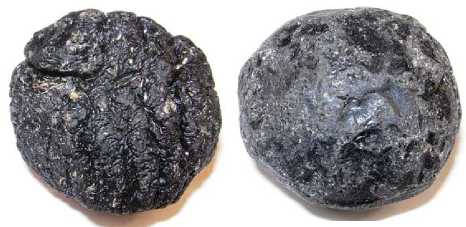 
Bediasite Georgianite
|
|
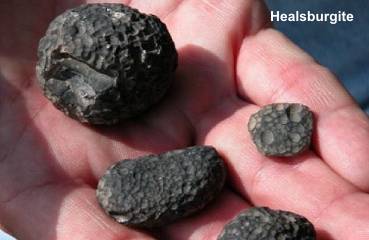 
|
|
3. Glassy lava
|
Dakhla Glass (Egypt)
|
Eruptiva type: Andesitic
|
Age: 28 -29 Ma (Oligocene)
|
|
The Dakhla glass is found in the western desert, nearby the oasis Dakhla. The Dakhla Glass (DG) is a glassy andesitic lava. The Dakhla Glass (DG) has emerged at the same time like the Libyan Desert Glass. Both differ however by the chemistry significantly. The DG has nothing to do with the LDG. The Dakhla Glass after transport and destruction was deposited in a new position. Now it is found as clumps in younger sediments.
See my report here
|
|
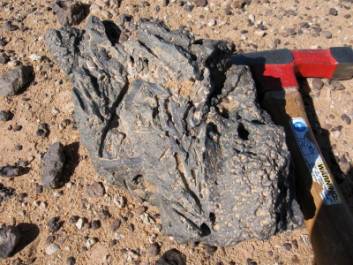
|

|
|
Edeowie Glass (Australia)
|
Type: Volcanic
|
Age: 0.67 Ma (Pleistocene)
|
|
In the South Australian Outback between the Flinders Ranges and the salt pan of Lake Torrens, roughly 400 km north of Adelaide, irregular masses and flat slabs of visicular, slaglike and glassy silicate melt have been found, locally quite abundant. These slabs of melt are associated with outcrops of baked sediments exhumed by water erosion and deflation. Features in quartz grains and Lechatelierite are present in the Edeowie Glass
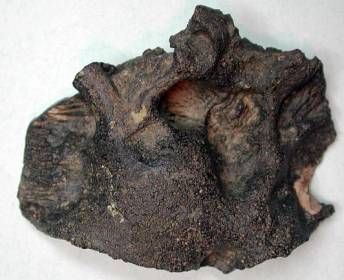  
|
|
Turkish Glass (Turkiye)
|
Type: Volcanic
|
Age: Pleistocene ?
|
|
Two Turkish mining engineers, Fatih Yüksel and Mehmet Topay, recently found specimens of volcanic glassy lava in the Turkish territory. They sent me photos and a spectral report of it. The samples were found in the region of the western Taurus mountains (near Burdur). This glassy lava is very similar to the Australian Edeowie glass.
Donald Kasper, Lancaster, California, wrote me in this sense: "The images show a pahoehoe lava. This type is highly fluid lava that forms glassy surfaces by quick cooling. In the shown spectral report the main peak must be quartz. The peak to the left would be tridymite. Lava would have magnetite peaks, but they are not evident in infrared spectroscopy in volcanic glasses I have studied so far."
|
|

|

|
|
|
| |
|
"Flädle" from Nördlinger Ries (Germany)
|
Eruptiva type: Dacitic-andesitic
|
Age: 15 Ma (Miocene)
|
|
The Nördlinger Ries and the Steinheim basin are interpreted meanwhile as classical impact structures. The famous "Suevite" should be an impact breccias and no volcanic breakout masses. The glass-bombs and glass-inclusions in the suevite ("Flädle") are interpreted as impact-melts. Also the occurrence of Shatter Cones prove apparently an impact event. The analyses of glass-melts against it point to it, that a dacitic-trachytic eruptiva quickly cooled down. The volcanic origin of the Nördlinger Ries and the Steinheim basin is by no means impossible. The Nördlinger Ries is located within the both large volcano regions in Germany, to which belong Eifel, Westerwald, Vogelsberg, Rhön on one hand and on the other hand in south the Kaiserstuhl, Steinsberg, Hegau and Urach.
Also here the question again: Are shock-metamorphe criterias exclusively reserved for impact events ? Was the Nördlinger Ries against all opinions an explosive volcano ? The melt speaks for it !
|
|

Glass bomb
|
|
Oxide (wt%)
|
Engelhardt, 1966
|
|
average (9)
|
average (17)
|
average (6)
|
|
SiO2
|
63.54
|
64.04
|
62.07
|
|
Al2O3
|
15.10
|
15.28
|
14.72
|
|
TiO2
|
0.81
|
0.78
|
0.85
|
|
FeO
|
3.75
|
2.39
|
3.37
|
|
MgO
|
2.71
|
1.71
|
2.63
|
|
CaO
|
3.45
|
3.98
|
3.62
|
|
Na2O
|
2.86
|
3.59
|
3.53
|
|
K2O
|
3.71
|
3.50
|
3.29
|
|
|

Glass -"Flädle"
|

|
|
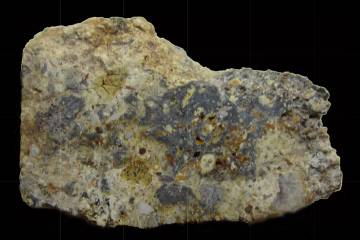
Suevite with "Flädle"
|

|
|
Glass of Rio Cuarto & Centinela del Mar regions (Argentinia)
|
Type: Differently eruptiva
|
Age: between 0.5/ 3.3/ 10 Ma
|
|
Three new strewn fields of "impact" glasses was located in Argentinia along the coastal sequences near Centinela del Mar and from near Rio Cuarto. These highly vesicular glasses contain evidence for an impact origin including temperatures sufficient to melt most mineral constituents (1700�C) and to leave unique quench products such as cristobolite. High-resolution 40Ar/39Ar dating methods yielded different ages of 0.5 Ma (Rio Cuarto) as well as 0.6 + 3.3 +10.0 Ma (Centinela del Mar).
All glasses are from similar chemical composition. The glass shards from the Rio Cuarto region (below) are an originally Fe-rich trachy-basaltic to trachy-andesitic eruptiva.
|
Oxide (wt%)
|
Glass scrap (1)
|
Sherules
|
|
clear part
|
brown p.
|
brown p.
|
brown p.
|
dark part
|
average (5)
|
|
SiO2
|
58.40
|
58.30
|
50.90
|
55.30
|
48.60
|
69.00
|
|
Al2O3
|
25.10
|
15.80
|
18.20
|
15.30
|
14.50
|
16.30
|
|
TiO2
|
0.00
|
2.00
|
1.40
|
2.70
|
3.50
|
0.64
|
|
FeO
|
1.40
|
10.30
|
13.70
|
14.00
|
20.10
|
3.80
|
|
MgO
|
0.34
|
1.70
|
2.30
|
2.80
|
2.30
|
1.40
|
|
CaO
|
6.50
|
4.15
|
8.00
|
4.80
|
5.00
|
3.40
|
|
Na2O
|
5.40
|
4.30
|
3.10
|
3.70
|
3.00
|
3.50
|
|
K2O
|
3.20
|
2.80
|
1.80
|
2.40
|
1.80
|
2.60
|
|

Glass scrap from the Rio Cuarto region
|
|
4. "Impact" glassy melt
|
Fluidal glass of Sudbury structure (Canada)
|
Eruptiva type: Andesitic
|
Age: 1850 Ma (Proterozoicum)
|
|

|
The Vredefort and Sudbury structures are probably the remains of the oldest supervolcanos on the earth. In the Sudbury structure (Slave Kraton) the oldest glassy melts are found in breccias. The SiO2 / Na2O + K2O ratio is of andesitic to dacitic composition. This correlates not with the noritic magma but with glasses of intrusions in the "Onaping" formation. |
|
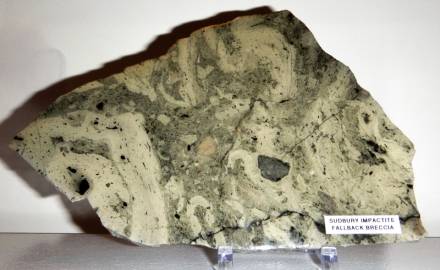
|

|
|
|
|
"Impact" melt glass of Chicxulub crater (Yucatan, Mexico)
|
Eruptiva type: Andesitic
|
Age: ~65 Ma
|
|
Why the Chicxulub-impact was an explosive supervolcano
|
|
  
|
|
|
|
Fluidal glass of El'gygytgyn crater (Chukotka, Siberia)
|
Eruptiva type: Dacitic-trachytic
|
Age: 3.6 Ma (Pliocene)
|
Chemical analyses of the glasses points to a dacitic-trachytic eruptiva. The chemistry has a high affinity to the Obsidian. The crater El'gygytgyn has a diameter of 18 km. The crater was formed in volcanic rock strata, which include tuffs and tuff-breccias as well as eruptive rocks of "basalts". The crater should be an impact - structure, because shock methamorphe features were shown. An explosive volcanic origin of the El'gygytgyn is much more probable however.
Also here the question again: Are shock-metamorphe criterias exclusively reserved for impact events ? No !
|
|
Oxide (wt%)
|
Gurov & Koeberl (2003) |
Gurov & Koeberl (2003) |
Gurov et al. (2005) |
| Melt glass |
Glass bombs |
Melt glass |
Glass bombs |
| range (9) |
average |
single |
single |
single |
single |
single |
single |
average (25) |
|
SiO2
|
68.60 |
70.44 |
69.63 |
70.50 |
71.91 |
71.62 |
70.22 |
73.07 |
69.37 |
69.70 |
|
Al2O3
|
14.41 |
15.84 |
15.22 |
15.41 |
14.23 |
15.21 |
15.79 |
14.30 |
14.69 |
15.12 |
|
TiO2
|
0.29 |
0.47 |
0.38 |
0.38 |
0.36 |
0.42 |
0.37 |
0.25 |
0.39 |
0.36 |
|
FeO
|
2.30 |
3.08 |
2.53 |
3.23 |
2.94 |
3.00 |
2.86 |
1.92 |
3.31 |
2.72 |
|
MgO
|
0.69 |
1.77 |
1.38 |
1.17 |
1.03 |
1.20 |
0.90 |
0.47 |
0.97 |
1.20 |
|
CaO
|
2.61 |
3.14 |
2.86 |
2.68 |
2.32 |
2.68 |
2.73 |
1.46 |
2.63 |
2.74 |
|
Na2O
|
2.66 |
3.16 |
2.87 |
2.72 |
2.74 |
2.17 |
3.13 |
2.62 |
3.24 |
2.90 |
|
K2O
|
3.30 |
4.37 |
3.72 |
4.00 |
3.91 |
3.94 |
4.36 |
4.12 |
4.10 |
3.76 |
|
|

Glass bomb
|

Fluidal inhomogeneous glass
|
|
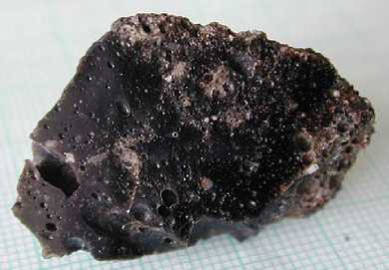
Source: impactites.net
|
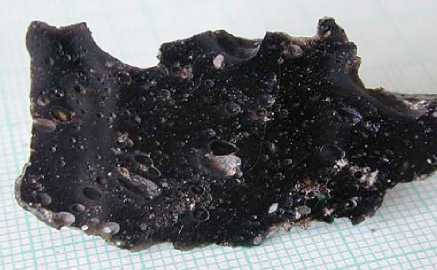
|
|
Fluidal glass of Zhamanshin crater (Kasakhstan)
|
Eruptiva type: Dacitic-rhyolitic + Basaltic-andesitic
|
Age: 0.9 - 1.1 Ma (Pleistocene)
|
|
The Zhamanshin structure is a circle depression ~6 km in diameter. The rim is formed of brecciated rocks. The structure include larger irregularly-shaped fragments and blocks of glassy melt (Zhamanshinite), and three types of splash-form glasses (Irghizite). These glassy objects typically are up to 30 mm large and are shaped as teardrops, irregularly bent and curved glass rods and fibers. They can be subdivided into acidic types (typically 69�76 wt.% SiO2) and basic types (typically 53�56 wt.% SiO2). That mean, Irgizhite are of dacitic-rhyolitic and basaltic-andesitic origin. The Irghizite glass include bubbles and grains of lechatelierite in some places. The water content of these glasses is with maximum 0.059 wt% atypically for an impactite glass. A volcanic origin of these glasses is much more probable. The Zhamanshin crater would be an endogenous structure with two (?) different eruptions. The related glassy melt bodies (Zhamanshinite) are of the same different origin as the Irghizite.
|
Oxide (wt%)
|
Zhamanshinite
|
Zhamanshinite (Si-rich)
|
Zhamanshinite (Si-poor)
|
|
Bouska et al. (1981)
|
Bouska et al. (1981)
|
Bouska et al. (1981)
|
|
range (12)
|
range (5)
|
average
|
single
|
range (16)
|
average
|
single
|
single
|
|
SiO2
|
62.90
|
88.10
|
75.50
|
71.46
|
77.80
|
73.89
|
72.01
|
52.42
|
56.73
|
54.34
|
55.34
|
53.79
|
|
Al2O3
|
14.80
|
21.20
|
18.00
|
10.99
|
15.55
|
13.25
|
15.55
|
19.61
|
22.16
|
20.59
|
22.16
|
20.07
|
|
TiO2
|
0.23
|
1.10
|
0.66
|
0.58
|
0.81
|
0.70
|
0.78
|
0.69
|
1.09
|
0.87
|
0.69
|
0.79
|
|
FeO
|
1.98
|
8.05
|
5.02
|
4.05
|
5.50
|
4.84
|
5.50
|
4.68
|
8.15
|
7.45
|
4.68
|
7.68
|
|
MgO
|
0.34
|
1.16
|
0.75
|
0.71
|
1.11
|
0.87
|
1.11
|
1.82
|
3.23
|
2.73
|
3.23
|
2.74
|
|
CaO
|
0.55
|
2.16
|
1.36
|
0.55
|
1.81
|
0.89
|
0.55
|
6.68
|
9.07
|
8.45
|
6.68
|
8.91
|
|
Na2O
|
0.57
|
1.84
|
1.20
|
0.88
|
1.85
|
1.43
|
1.10
|
3.24
|
4.55
|
3.94
|
4.55
|
3.48
|
|
K2O
|
0.10
|
3.07
|
1.58
|
2.70
|
2.99
|
2.89
|
2.89
|
1.22
|
1.85
|
1.40
|
1.84
|
1.42
|
|
|

|
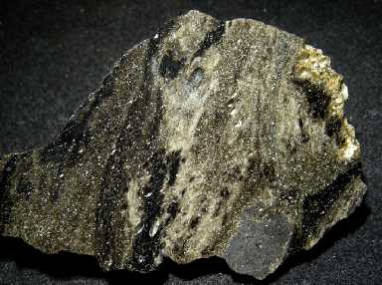
| |





















































































































